Pump Handbook by Igor J. Karassik, Joseph P. Messina, Paul Cooper, Charles C. Heald - 3rd edition
Подождите немного. Документ загружается.

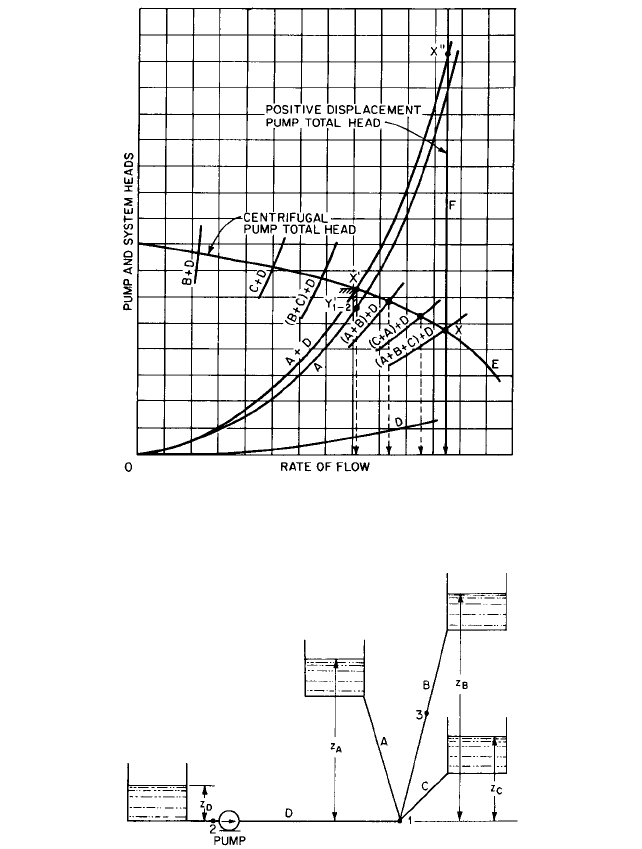
8.2 BRANCH-LINE PUMPING SYSTEMS 8.85
FIGURE 3 System-head curves for pump and branch line shown in Figure 1 with different combinations of open
valves
FIGURE 4 Open-ended pumping system with branch lines
line and main supply line considered independently of each other. These curves are con-
structed by starting at elevation heads Z
A
, Z
B
, Z
C
and Z
D
at zero flow. To each of these
heads is added the frictional resistances in each line for several flow rates. Frictional
losses from the suction tank to junction 1 are included in curve D. Curves A, B, C,and D
therefore represent the variation in system resistance in feet (meters) versus flow through
each branch and supply line. Note that Z
D
is negative because in line D there is a decrease
in elevation to point 1.
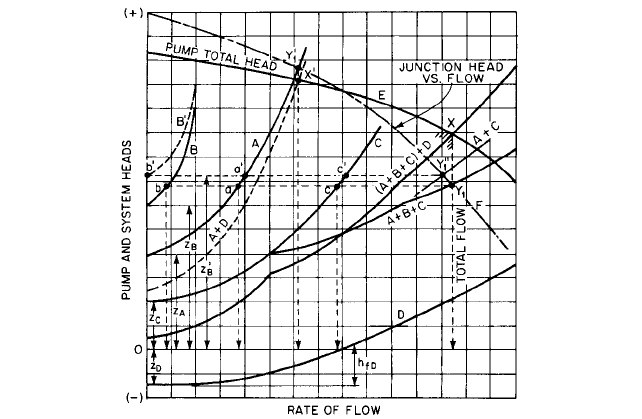
8.86 CHAPTER EIGHT
FIGURE 5 System-head curves for pump and branch lines shown in Figure 4
The total head at the junction is the head Z
D
in the suction tank measured above point
1 plus the pump total head less the frictional head loss h
fD
in line D, and it varies with flow,
as illustrated by curve F.
The total system resistance, total pump flow, and individual branch flows are found
by the following method. First observe that (a) the total flow must be equal to the sum of
the branch flows, (b) the frictional resistance plus the elevation head measured relative
junction 1 for each branch is identical and (c) the flow divides to produce these identical
total branch heads. Therefore, at several head points, add together the flow of each
branch to obtain curve A B C. Supply line D is in series with branches A, B,and C,
and their system heads are added algebraically for several flow conditions to obtain
curve (A B C) D. If curve E is the head-capacity characteristics of a centrifugal
pump, point X represents the pump flow because at this point the system total head and
pump total head are equal. Point Y
1
represents the total head at junction 1, and this head
determines the flow through each branch; consequently points a, b, and c give individual
branch flows.
In this example the pump discharges to all tanks, but this should not be assumed.
There is a limiting liquid level elevation for each tank, and, if this level is exceeded, flow
will be from the tank into the junction. Therefore it is possible for the lower-level tanks to
be fed by the higher-level tank and the pump. The limit for the liquid elevation in tank B
is Z¿
B
, and it is found from the intersection of curve A C with curve F, point Y –
1
. The flow
in branches A and C is at rates a¿ and c¿ when there is no flow in branch B. This is also a
condition similar to closing a valve in branch B.
If elevation Z
B
is greater than previously found limiting height Z¿
B
flow in branches A
and C is determined in the following manner. Construct a curve for junction head versus
flow by adding heads and flows that result when the pump and suction tank are in a series
with each other and tank B (less line losses) is in parallel with the pump and suction tank.
The intersection of this curve with curve A C will give the junction head required to
determine the individual flows from the pump and tank and the flows to tanks A and C (not
illustrated).
If flow to branches B and C is shut off, Figure 5 illustrates the construction of the
curves required to determine the pump flow point X¿ and junction head point Y ¿
1
.
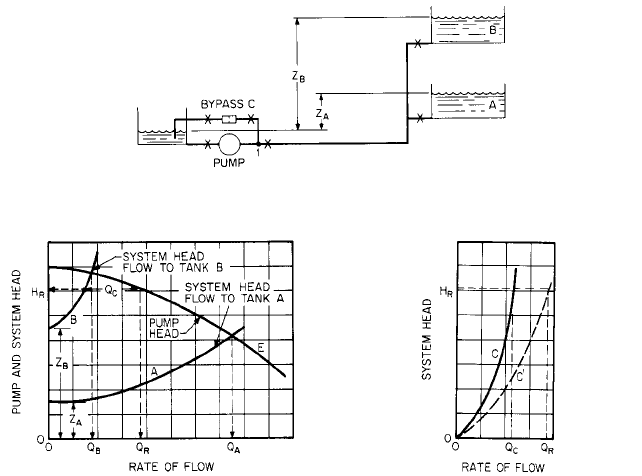
8.2 BRANCH-LINE PUMPING SYSTEMS 8.87
FIGURE 6 Pump with bypass to maintain minimum flow
FIGURE 7 System-head curves for pump and tanks
shown in Figure 6 with bypass valve closed
FIGURE 8 Bypass orifice system requirements
CENTRIFUGAL PUMP BYPASS _________________________________________
Bypass orifices around centrifugal pumps are often used to maintain a minimum flow rec-
ommended by the pump manufacturer because of one or more of the following reasons:
• To limit the temperature rise to prevent seizing and cavitation
• To reduce shaft and bearing loads
• To prevent excessive recirculation in the impeller and casing
• To prevent overloading of driver if pump power increases with decrease in flow
Figure 6 illustrates a system that under certain conditions reduces pump flow below
the recommended minimum. The pump delivers its flow to either tank A or tank B. Figure
7 shows the separate system-head curves for flow to tank A and for flow to tank B. Curve
E is the head-capacity characteristics of the centrifugal pump. Individual flow rates to
each tank are shown as Q
A
and Q
B
. The recommended minimum flow is Q
R
, which is
greater than Q
B
by the amount shown. In order to maintain the minimum flow, a bypass
orifice with necessary pipe, valves, and fittings is required to pass flow Q
c
at total head H
R
is when the pump discharges to tank B only.
Figure 8, (curve C) shows the construction necessary to determine the required bypass
head versus flow characteristics of the orifice and pipe. The bypass system-head curve C
includes the pipe, valve, and fitting losses from the pump connection between the suction
tank and the end of the bypass piping below the suction water level. These losses must be
deducted from the total bypass losses to determine the required orifice head.
Figure 9 illustrates the resultant pump flow with the bypass in operation. Curve C is
added to curve B to obtain curve B C by combining flows through each system at the
same heads. Note that flow through the piping from the suction tank to junction 1 is the
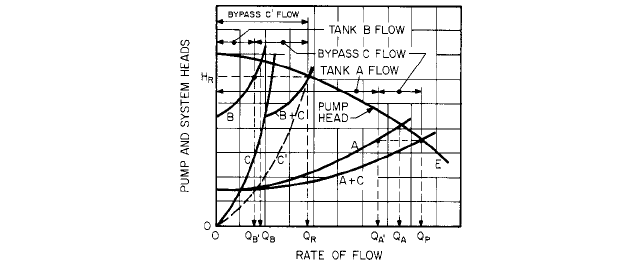
8.88 CHAPTER EIGHT
FIGURE 9 System-head curves for pump and tanks shown in Figure 6 with bypass valve open
total from both systems. Therefore, the combined system-head curve B C should take
this into consideration. Similarly, curve C is added to curve A to obtain curve A C. Note
that when the flow is directed to tank B with the bypass open, pump flow is increased from
Q
B
to Q
R
and tank flow is decreased from Q
B
to Q¿
B
. When the flow is directed to tank A
with the bypass open, pump flow is increased from Q
A
to Q
p
and tank flow is decreased
from Q
A
to Q¿
A
.
If it is desired that there be no reduction in flow or that there be no waste of pumping
power when flow is to tank A, the bypass can be closed either manually or automatically.
If pump flow is monitored, this measurement can be used to open, close, or modulate the
bypass valve automatically to maintain desired flow. Refer to Subsection 2.3.4 for more
detailed information.
If operating procedures require that the pump occasionally be run with a closed valve
(at the pump discharge or at tanks A and B), the bypass line must be designed to recircu-
late all of the minimum required pump flow Q
R
, dissipating head H
R
, shown as curve C¿
and Figures 8 and 9.
FLOW CONTROL THROUGH BRANCHES_________________________________
The flow through branches A, B, and C in Figures 1 and 4 is dependent on the individual
branch characteristics. When parallel branches are connected to a pump, the resulting
division of flow may not satisfy the requirements of the individual lines. If it is desired that
the flow to each branch meet or exceed specified individual line requirements, it is neces-
sary only to select a pump to provide the maximum head required by any one branch. In
those branches where this head is more than required, the flow will be greater than the
desired amount. A throttling valve or other flow-restricting device may be used to reduce
the flow in these branches to the desired quantity. If the flow is controlled in this manner,
the pump need be selected to produce only the minimum total system flow at a total head
required to satisfy the branch needing the highest head at junction 1 in Figures 1 and 4.
The flow through a branch is sometimes dictated by the requirement of a component
elsewhere in the system. For example, in the system shown in Figure 10, the required flow
through component V could be greater than the sum of the required flows through com-
ponents A, B, and C. An additional branch line and control valve F around components A,
B, and C may be used to bypass the additional flow needed by component D. Individual
component throttling valves may also be used, if needed, to adjust the flow in each branch.
The following example illustrates how flow through branches may be controlled and
how pump total head is calculated.
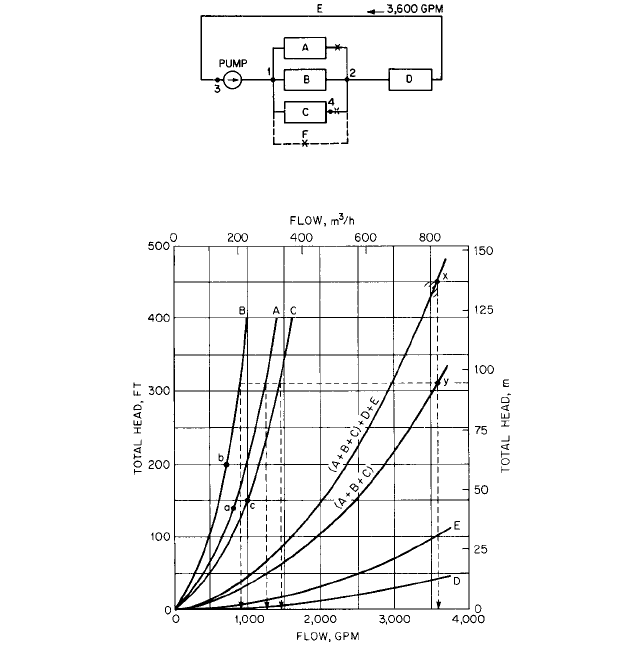
8.2 BRANCH-LINE PUMPING SYSTEMS 8.89
FIGURE 10 Example of a branch-flow pumping system
FIGURE 11 System-head curves required for solutions to example problems
EXAMPLE
A pump is required to circulate water at a rate of 3600 gpm (817 m
3
/h)
through the system shown in Figure 10. The head versus flow characteristics of the
system components A, B, C, D, and E (system pipe and fittings) are shown in Figure 11.
The branch pipe and fitting losses from point 1 to point 2 are included in the total
heads for components A, B, and C. Determine
1. The pump total head required and the individual flows through components A,
B, and C
2. The pump total head required if the flow through components A, B, and C need
be only 800, 700, and 1000 gpm (182, 159, and 227 m
3
/h), respectively, and a
bypass F is installed
Calculate the individual throttling valve head drops to achieve a controlled branch
flow system.
Solution
1. Head versus flow curves A, B, and C of Figure 11 are added together in parallel,
giving curve (A B C). Curves (A B C), D,and E are added together in
8.90 CHAPTER EIGHT
series, resulting in curve (A B C) E E. This latter curve indicates that
450 ft (137 m) total pump head is required at 3600 gpm (817 m
3
/h), point X. Curve
(A B C) crosses point Y at 3600 gpm (817 m
3
/h) flow through the branches,
and this condition requires 310 ft (94.5 m) total head, which is the head across
branch points 1 and 2. From each individual component curve, the flow through
branches A, B, and C can be read as 1250, 900, and 1450 gpm (284, 204, and 329
m
3
/h), respectively.
2. Because the total flow through components A, B, and C need be only 2500 gpm
(800 700 1000) [568 m
3
/h (182 159 227)], the bypass should be designed
to pass 1100 gpm (249 m
3
/h). Component B requires the maximum head, 200 ft
(61 m) differential (point b) across points 1 and 2. Throttling valves are needed in
components A and C and bypass F to increase the head in each branch to 200 ft
(61 m) at the required flows. Branch A (point a) requires only 140 ft (42.7 m) total
head to pass 800 gpm (182 m
3
/h); therefore the throttling valve must be designed
for a 60-ft (42.7-m) head loss. Branch C (point c) requires only 150 ft (45.7 m) total
head to pass 1000 gpm (227 m
3
/h), requiring a throttling valve for a 50-ft (15.3-m)
head loss. The bypass control valve and piping should be designed to produce a
200-ft (61-m) head drop at 1100 gpm (249 m
3
/h).
At 3600 gpm (817 m
3
/h), the pump is now required to overcome 200 ft (61 m) total head
across points 1 and 2, 40 ft (12.2 m) total head through component D, and 100 ft (30.1 m)
total head through the system pipe and fittings, component E, for a total of 340 ft
(103.3 m). The reduction in pumping head from 450 to 340 ft (137.1 to 103.6 m), a saving
of 110 ft (33.5 m), or 24.4% water power, is the result of decreasing the branch head from
310 to 200 ft (94.5 to 61 m) by bypassing the excess flow.
PUMP TOTAL HEAD IN BRANCH-LINE SYSTEMS __________________________
The total head produced is the difference in total heads measured across the suction and
discharge connections of a pump.As explained in Section 8.1, the total head is also the dif-
ference between the heads at any two points in the pumping system, one on each side of
the pump, plus the sum of the head losses between these two points. Confusion sometimes
results when the flow through the pump divides into branches in either closed-loop or
open-ended systems.The points of head measurement can be in any branch line, upstream
or downstream from the pump, regardless of the flow rate in these lines.
In part 2 of the previous example, the pump or system total head could be measured
using points 3 and 4 in Figure 10. If the total head measured at the pump suction, point
3, were 25 ft (7.62 m) gage, the head measured at point 4 would be 205 ft (62.48 m) gage
above the same reference datum plane, assuming 10 ft (3.05 m) of friction between the
pump discharge and point 1. The difference between the head at point 3 and that at point
4 is 180 ft (54.86 m). The loss of head due to friction and the head drop through component
C is 10 150 160 ft (3.05 47.5 48.75 m). The pump and system total head at 3600
gpm (817 m
3
/h) is therefore 180 160 340 ft (54.86 48.75 103.63 m).
Similarly, the pump and system total head for an open-ended system, such as the one
shown in Figure 4, could be found by measuring, for example, the difference between the
head at point 2 and that at point 3. Each head measurement would be referred to a com-
mon datum plane.The total head loss from 2 to 1 plus the head loss from 1 to 3, at the rate
of flow in their respective lines, added to the difference between the head at 2 and that at
3, is the pump and system total head.

JOHN PARMAKIAN
8.91
SECTION 8.3
WATERHAMMER
Waterhammer is a very destructive force that exists in any pumping installation where
the rate of flow changes abruptly for various reasons. Most engineers recognize the exis-
tence of waterhammer, but few realize its destructive force. Much time and expense have
been spent repairing pipelines and pumps damaged by waterhammer. It is thus essential
for an engineer to be able to know when to expect waterhammer, how to estimate the pos-
sible maximum pressure rise, and, if possible, how to provide means to reduce the maxi-
mum pressure rise to a safe limit.
The computational procedures used for the analysis of waterhammer in pump dis-
charge lines with electric-motor-driven pumps have been known for many years, begin-
ning with the basic waterhammer contributions by Joukousky and Allievi.This work was
followed in later years by many applications of numeric, graphic, and computer tech-
niques. Although the theory and mechanics of computing waterhammer in pump dis-
charge lines have advanced rapidly in recent years, there are many practical aspects of
this subject that are still confusing to engineers. It is the purpose of this section to bring
these to the reader’s attention. The first and major portion of the section contains a dis-
cussion of some practical aspects of waterhammer control devices used in pumping plants;
the second indicates the source of various charts that provide ready waterhammer solu-
tions for a variety of these control devices.
NOMENCLATURE ____________________________________________________
The following is a list of variables commonly used in waterhammer computations. The SI
conversion factors for these terms are to be found in Table 1.
a velocity of pressure wave, ft/s
D inside diameter of conduit, ft

8.92 CHAPTER EIGHT
TABLE 1 SI conversions
To convert To Multiply by
GD
2
(kg m
2
) WR
2
(lb ft
2
) 23.73
kg/m
2
lb/ft
2
0.2048
kg/m
3
lb/ft
3
0.06243
m ft 3.281
m/s ft/s 3.281
m/s
2
ft/s
2
3.281
m
3
/s ft
3
/s 35.32
mm ft 3.281 10
3
e thickness of pipe wall, ft
E Young’s modulus for pipe material, lb/ft
2
g acceleration of gravity, ft/s
2
H
o
pumping head for initial steady pumping conditions, ft
H
R
rated pumping head, ft
K
1
91,600 H
R
Q
R
/WR
2
nR
N
2
R,
s
1
K volume modulus of liquid, lb/ft
2
L total length of conduit, ft
2L/a round-trip wave travel time, s
N
R
rated pump speed, rpm
h
R
pump efficiency at rated speed and head, decimal form
r pipe line constant
Q
0
initial flow through pump, ft
3
/s
Q
R
rated flow through pump, ft
3
/s
m Poisson’s ratio of pipe material
V
0
velocity in conduit for initial steady conditions, ft/s
w specific weight of water, lb/ft
3
WR
2
flywheel effect of rotating parts of motor, pump, and entrained water, lb-ft
2
BASIC ASSUMPTIONS ________________________________________________
A considerable number of assumptions were made in the derivation of the fundamental
water-hammer equations and in the solution of the various hydraulic transients in pump-
ing systems. These assumptions are often overlooked and involve the physical properties
of the fluid and pipeline, the kinematics of the flow, and the transient response of the
pump as follows:
1. The fluid in the pipe system is elastic, of homogeneous density, and always in the
liquid state.
2. The pipe wall material or conduit is homogeneous, isotropic, and elastic.
3. The velocities and pressures in the pipeline, which is always flowing full, are uni-
formly distributed over any transverse cross-section of the pipe.
4. The velocity head in the pipeline is negligible relative to the pressure changes.
aV
o
>gH
o
8.3 WATERHAMMER 8.93
5. At any time during the pump transient, when operation is in the zones of pump oper-
ation, energy dissipation, and turbine operation, there is an instantaneous agreement
at the pump, as defined by the steady-state complete pump characteristics of the
pump speed and torque corresponding to the transient head and flow that exist at that
moment at the pump.
6. The length between the inlet and outlet of the pump is so short that waterhammer
waves propagate between these two points instantly.
7. Windage effects of the rotating elements of the pump and motor during the transients
are negligible.
8. Water levels at the intake and discharge reservoirs do not change during the transient
period.
FACTORS AFFECTING WATERHAMMER _________________________________
High- and Low-Head Pumping Systems
Waterhammer is of greater significance in
low-head pumping systems than in high-head systems. The normal steady water veloci-
ties in high-head and low-head pumping systems are usually of about the same order of
magnitude. However, the pressure changes are proportional to the rate of change in the
velocity of the water in the line. For a given rate of velocity change, however, the pressure
changes in the high- and low-head pumping systems are of about the same order of mag-
nitude. Therefore, a given head rise would be a larger proportion of the pumping head in
a low-head pumping system than a high-head system.
Discharge Line Profile The pump discharge line profile is usually based on economic,
topographic, and land right-of-way considerations. However, in selecting the alignment
along which a pump discharge line is to be located, there are other considerations that
often make one pipeline profile and alignment more favorable than another. For example,
upon a power failure at the pump motors, the envelope of the maximum downsurge gra-
dient along the length of the pipeline is a concave curve. Therefore it may be possible to
avoid the use of expensive pressure control devices at a pumping plant if the pipeline pro-
file is also concave and is not located above the downsurge gradient curve. In some cases,
it may even be economical to lower the profile of the discharge line at the critical loca-
tions by deeper excavation. If a surge tank at the pumping plant is definitely required,
the most favorable pipeline profile is one with high ground near the pumping plant where
the surge tank structure can be placed so its height above the natural ground line will be
much less than what would be necessary if there were no high ground near the plant.
Rigid Water Column Theory The question is often raised as to whether the rigid water
column theory is sufficiently accurate for the computation of waterhammer in pump dis-
charge lines. In the rigid water column theory, the water is assumed to be incompressible
and the pipe walls rigid. In the author’s experience, the accuracy and limitations of the
rigid water column theory are often questionable for most waterhammer problems that
occur in pump discharge lines.
Waterhammer Wave Velocity From a practical viewpoint, a difference of 15 to 20% in
the magnitude of the computed waterhammer wave velocity usually has very little effect
on the waterhammer in pump discharge lines. The effect on the waterhammer due to a
possible error in the wave velocity can be verified by first computing the wave velocity as
accurately as possible and then recomputing the transients for the critical cases with a
wave velocity about 20% higher or lower. At installations where alternative materials for
the pipeline are being investigated, one waterhammer wave velocity and solution for
waterhammer for either alternative will usually suffice regardless of the pipe material
finally selected.
8.94 CHAPTER EIGHT
Pipeline Size The diameter of the pipeline is usually determined from economic con-
sideration based on steady-state pumping conditions. However, the waterhammer effects
in a pump discharge line can be reduced by increasing the size of the discharge line
because the velocity changes in the larger pipeline will be less. This is usually an expen-
sive method of reducing waterhammer in pump discharge lines, but there are sometimes
occasions where an increase in pipe size may be justified to avoid the use of more expen-
sive waterhammer control devices.
Number of Pumps The number of pumps connected to each pump discharge line is usu-
ally determined from the operational requirements of the installation, availability of
pumps, and other economic considerations. However, the number and size of pumps con-
nected to each discharge line have some effect on the waterhammer transients. For pump
start-up with pumps equipped with check valves, the greater the number of pumps on
each discharge line, the smaller the pressure rise. Moreover, if there is a malfunction at
one of the pumps or check valves, a multiple pump installation on each discharge line
would be preferable to a single pump installation because the flow changes in the dis-
charge line due to such a malfunction would be less with multiple pumps. When a simul-
taneous power failure occurs at all of the pump motors, the fewer the number of pumps
on a discharge line, the smaller the pressure changes and other hydraulic transients. For
a given total flow in the discharge line, a large number of small pumps and motors will
have considerably less total kinetic energy in the rotating parts to sustain the flow than
a small number of pumps. Consequently, for the same total flow, the velocity changes and
waterhammer effects due to a power failure are a minimum when there is only one pump
connected to each discharge line.
Flywheel Effect (WR
2
) Another method for reducing the waterhammer effects in pump
discharge lines is to provide additional flywheel effect (WR
2
) in the rotating element of
the motor. As an average, the motor usually provides about 90% of the combined flywheel
effect of the rotating elements of the pump and motor. Upon a power failure at the motor,
an increase in the kinetic energy of the rotating parts will reduce the rate of change in
the flow of water in the discharge line. In most cases, an increase of 100% in the WR
2
of
large motors can usually be obtained at an increased cost of about 20% of the original cost
of the motor. Ordinarily, an increase in WR
2
is not an economical method for reducing
waterhammer, but it is possible in some marginal cases to eliminate other, more expen-
sive pressure control devices.
Specific Speed of Pumps For a given pipeline and initial steady-flow conditions, the
maximum head rise that can occur in a discharge line subsequent to a power failure where
the reverse flow passes through the pump depends first on the magnitude of the maxi-
mum reverse flow that can pass through the pump during the energy-dissipation and
turbine-operation zones. Secondarily, it depends on the flow that can pass through the
pump at runaway speed in reverse. Upon a power failure, the radial-flow (low-specific-
speed) pump will produce slightly more downsurge than the axial-flow (high-specific-
speed) and mixed-flow pumps.
1
The radial-flow pump will also produce the highest head
rise upon a power failure if the reverse flow is permitted to pass through the pump. There
is usually very little head rise at mixed-flow and axial-flow pumps when a power failure
occurs and if a water column separation does not occur at some other location in the line.
During a power failure with no valves, the highest reverse speed is reached by the
axial-flow pump and the lowest by the radial-flow pump. Care must therefore be taken to
prevent damage to the motors with the higher-specific-speed pumps because of these
higher reverse speeds. Upon pump start-up against an initially closed check valve, the
axial-flow pump will produce the highest head rise in the discharge line because it also has
the highest shutoff head. On pump start-up, a radial-flow pump will produce a nominal
head rise, but an axial-flow pump can produce a head rise of several times the static head.
Complete Pump Characteristics In order to determine the transient conditions due
to a power failure at the pump motors, the waterhammer wave phenomena in the pipeline,
the rotating inertia of the pump and motor, and the complete pump characteristics as well
